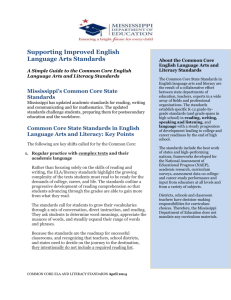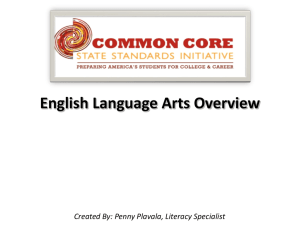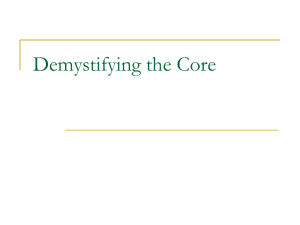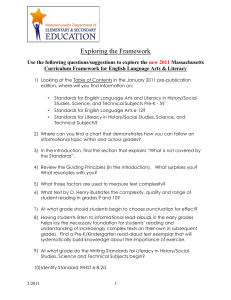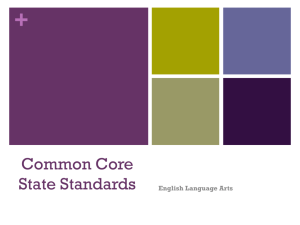File
advertisement
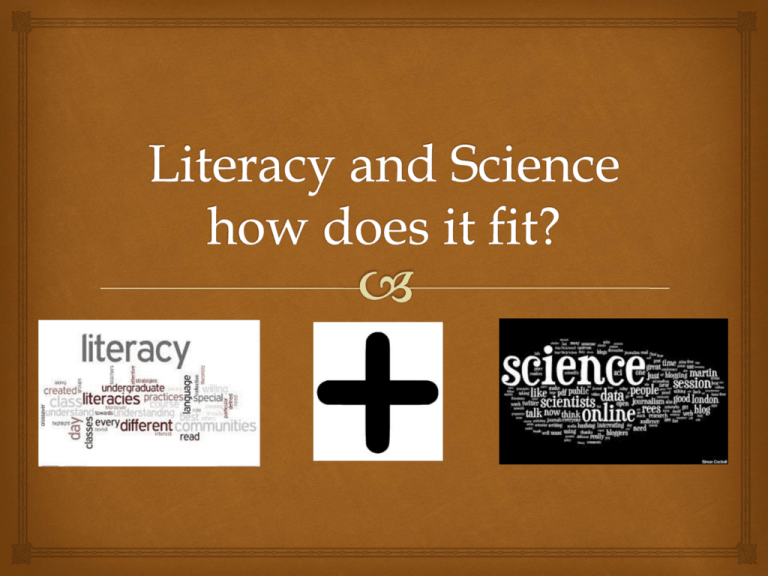
Which one are you? Why discuss literacy? Researchers have found that students learn science better when they write about their thinking and that the act of writing may force integration of new ideas and relationships with prior knowledge. (Thier and Daviss, 2002) Shared Responsibility “The grades 6–12 standards are divided into two sections, one for ELA and the other for history/social studies, science, and technical subjects. This division reflects the unique, time-honored place of ELA teachers in developing students’ literacy skills while at the same time recognizing that teachers in other areas must have a role in this development as well.” . Literacy and Subjects No more guess work…subject standards include the literacy connection but additional connections can be made further. Know how to interpret the literacy part of the standard to show a seamless connection and flow. Shifts in ELA/Literacy 1. Building knowledge through content-rich nonfiction 2. Reading, writing and speaking grounded in evidence from text, both literary and informational 3. Regular practice with complex text and its academic language Shift #1: Building Knowledge Through Content-Rich Nonfiction www.achievethecore.org 11 Building Knowledge Through Content-rich Nonfiction – Why? • Students are required to read very little informational text in elementary and middle school. • Non-fiction makes up the vast majority of required reading in college/workplace. • Informational text is harder for students to comprehend than narrative text. • Supports students learning how to read different types of informational text. Distribution of Literacy and Informational Texts All Teachers Support Literacy This interdisciplinary approach to literacy stems from extensive research establishing the need for college and career ready students to be proficient in reading complex informational texts, independently, in a variety of content areas. Most of the required reading in college and workforce training programs is informational in structure and challenging in content Postsecondary education programs typically provide students with both a higher volume of such reading than is generally required in K–12 schools and comparatively little scaffolding. The 2009 reading framework of the National Assessment of Educational Progress (NAEP) requires a high and increasing proportion of informational text on its assessment as students advance through the grades. Shift #2: Reading, Writing and Speaking Grounded in Evidence From Text, Both Literary and Informational www.achievethecore.org 18 Reading, Writing and Speaking Grounded in Evidence from Text: Why? • • Most college and workplace writing requires evidence. • Ability to cite evidence differentiates strong from weak student performance on NAEP. • Being able to locate and deploy evidence are hallmarks of strong readers and writers. Evidence is a major emphasis of the ELA Standards: Reading Standard 1, Writing Standard 9, Speaking and Listening standards 2, 3 and 4, all focus on the gathering, evaluating and presenting of evidence from text. Shift #3:Regular Practice with Complex Text and Its Academic Language Regular Practice With Complex text and Its Academic Language: Why? • Gap between complexity of college and high school texts is huge. • What students can read, in terms of complexity, is greatest predictor of success in college ( 2006 ACT study). • Too many students are reading at too low a level. • Standards include a staircase of increasing text complexity from elementary through high school. • Standards also focus on building general academic vocabulary so critical to comprehension. Shifts in ELA/Literacy 1. Building knowledge through content-rich nonfiction 2. Reading, writing and speaking grounded in evidence from text, both literary and informational 3. Regular practice with complex text and its academic language Practices in Science, Mathematics, and English Language Arts (ELA) Practices in Math, Science, and ELA* Practices in Mathematics, Science, and English Language Arts* Math Science M1. Make sense of problems and persevere in solving them. S1. Asking questions (for science) and defining problems (for engineering). M2. Reason abstractly and quantitatively. S2. Developing and using models. M3. Construct viable arguments and critique the reasoning of others. M4. Model with mathematics. M5. Use appropriate tools strategically. S3. Planning and carrying out investigations. S4. Analyzing and interpreting data. S5. Using mathematics, information and computer technology, and computational thinking. S6. Constructing explanations (for M6. Attend to precision. science) and designing solutions (for engineering). M7. Look for and make use of structure. S7. Engaging in argument from evidence. M8. Look for and express regularity in repeated S8. Obtaining, evaluating, and reasoning. communicating information. English Language Arts E1. They demonstrate independence. E2. They build strong content knowledge. E3. They respond to the varying demands of audience, task, purpose, and discipline. E4. They comprehend as well as critique. E5. They value evidence. E6. They use technology and digital media strategically and capably. E7. They come to understanding other perspectives and cultures. * English Language Arts uses the term “student capacities” rather than the term “practices” used Mathematics and the Next Generation Science Standards. Math Science M4. Models with mathematics M1: Make sense of problems S2: Develop & use models S1: Ask questions and define problems and persevere in solving them S5: Use mathematics & S3: Plan & carry out investigations M2: Reason abstractly & computational thinking quantitatively S4: Analyze & interpret data M6: Attend to precision S6: Construct explanations E2: Build a strong base of & design solutions M7: Look for & make knowledge through content rich use of structure texts M8: Look for & E5: Read, write, and speak make use of E6: Use grounded in evidence S8: Obtain, regularity technology evaluate, & M3 & E4: Construct viable in repeated & digital media communicate arguments and critique reasoning strategically & information reasoning of others capably E3: Obtain, synthesize, S7: Engage in M5: Use and report findings clearly argument from appropriate tools and effectively in response evidence strategically to task and purpose Commonalities Among the E1: Demonstrate independence in reading complex Practices texts, and writing and speaking about them in Science, E7: Come to understand other perspectives Mathematics and cultures through reading, listening, and English and collaborations Based on work Language Arts ELA by Tina Chuek ell.stanford.ed u What does this mean in regard to instruction in the classroom Students will have to read complex text. Research ideas and topics for classroom discussion and experimentation. Be able to argue their point and back up their statements with specific information from research and hands on activities. Constantly be reading, writing, speaking and creating in the science classroom. Examples of Literacy in Science (video) https://www.teachingchannel.org/videos/ccss-literacyscience-classroom https://www.teachingchannel.org/videos/pairing-studentsin-classroom https://www.teachingchannel.org/videos/science-lessonmagnets Take notes on the students and teachers discussions/actions. How would this be helpful in your classroom and how easy would the above be to implement. Science and language are interdependent. Their processes are mirrored in each other. Students at all levels should be able to: Note details Compare and contrast Predict Sequence events Link cause and effect Distinguish fact from opinion Link words with precise meanings Make inferences Draw conclusions From Thier and Daviss, 2002 Strategies to improve literacy in science. Use prompts to uncover ideas. Predicting: What does the topic title reveal? Reflective questioning before reading: What does this topic mean to me? Reflective questioning after reading: What questions do I still have about this topic? Evaluating: What it is the main idea of this reading? Paraphrasing: Turn and talk with a classmate about the reading. Summarizing: How many key ideas can I identify? Identifying words and meanings: Do I understand the meaning of the reading? Reflecting on the overall reading: If I reread this topic, what areas would I focus on? Expectations A successful 21st century student must : Be able to read material that is age/grade appropriate Decipher readings that are challenging Make arguments and present claims Be able to write fluidly and with clarity Be able to pull information needed from text and research materials Problem solve using pervious knowledge and research to back their position up. (science specific – be able to create their experimental design, complete the experiment and conclude the findings in a detailed, factual based format. The Art of Argumentation Ross, Fisher and Frey Science and Children, 2009, p.29 Interactive Notebooks http://www.sciencenotebooks.org/ What can go on the left side of an interactive notebook? Brainstorming Discovery headlines Biography posters Concept maps Riddles Your questions Pictographs Cartoons Poetry and songs Significant statements Flowcharts Graphic organizers Drawings Metaphors and analogies Venn diagrams Bulls-Eye diagrams Data and graphs you generate Analysis writing Reflection writing Quick-writes Four square analogies Mnemonics Writing prompts Scientific conclusions Other creative avenues for processing information All sorts of student work!!! What goes on the right side of an interactive notebook? Student generated question Factual Information Why are plants Scientists note that green instead of blue plants are green. Many or red? hypotheses have been proposed to understand plant color. ….. How does photosynthesis work Plants….. to make food? Summary Photosynthesis is a process….. The Cornell note style helps students think reflectively about a topic, generate questions, which the teacher can facilitate during instruction. http://teacher.ocps.net/susan.co lwell/media/inbinsertsv3.pdf Some resources http://www.scienceandliteracy.org/teachersupport/strategyguides http://score.rims.k12.ca.us/teachers/contentliteracy/ http://www.learninga-z.com/commoncore/close-reading.html http://www.aspendrl.org/portal/browse/DocumentDetail?doc umentId=1396&download http://www.tennessee.gov/education/ci/english/doc/READ_Gr_68_Content_Area.pdf Discussion and Wrap Up Discuss questions and answers from the day Needed support from me
